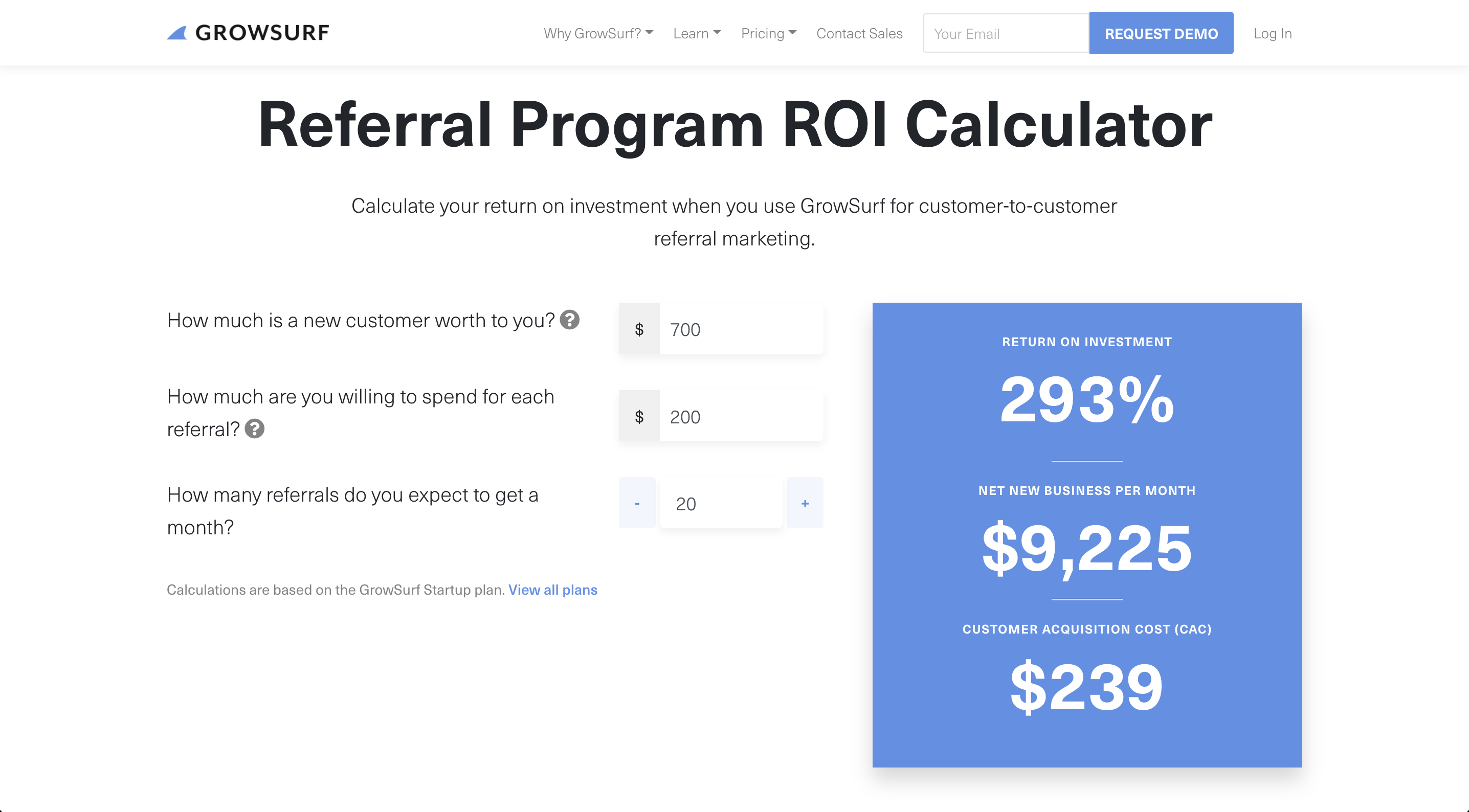Put your growth on autopilot
GrowSurf is modern referral program software that helps product and marketing teams launch an in-product customer referral program in days, not weeks. Start your free trial today.
Referral programs are a great way to increase customer loyalty, customer lifetime value, and new customer acquisition. They also help your business grow through word-of-mouth marketing. When done correctly, they can be a huge success for your business.
But how much does a referral program cost?
Here's a fact:
There's not a number set in stone when it comes to referral program costs. Instead, this will depend on several factors, including:
Calculating the costs associated with your referral program is critical. It's a valuable piece of information that can help you measure the ROI of your program which can give you a clear picture of how much you're investing and how much you're getting in return.
When trying to calculate your referral program costs, there are three crucial elements that you must consider:
Let's say that you have a customer base of 100. Managing a referral program manually by using spreadsheets when you have a small number of customers seems doable.
But what happens when your customer base grows to 10,000? How do you make sure everyone hears about your referral program or track down your best referrers?
You use a referral program software!
Referral marketing software is there to help you manage this by tracking down your most active referrers, automating your sending out of rewards, and providing you with insights into your referral program performance.
The good news is there's a wide range of different referral marketing software to choose from. The best one will depend on your budget and your needs.
This brings me to my point:
The cost of the referral program software you'll opt for will influence the cost of the referral program. Some solutions cost a few hundred dollars per month and others thousands.
For instance, Growsurf offers three paid plans that you can subscribe to, starting from $179/month. If you need an advanced set of features and integrations, opting for the Business Plan might be your best option. However, if your needs are humble, the Startup Plan sounds ideal.
In addition to the referral program software you'll be using, the type of referral rewards you decide to give out will also define your referral program costs.
For example, giving cash rewards can be more expensive than subscription points. But at the same time, cash rewards are a great short-term strategy to gain traction.
Subscription points or credits are useful if your product/service is “pay-per-use” or purchased on a regular basis. Discounted services are a sure way to boost sales and encourage customer loyalty.
And so on.
So, let's imagine you're offering $10 for every successful referral. It's a double-sided reward where both the referrer and the referred get $10. You're getting 25 successful referrals per month, which means you're spending $500 per month on referral rewards. On a yearly level, that's $6,000.
I know what you may be thinking:
But $6,000 seems like a large amount of money to spend on referral rewards!
Yes, you're spending $6,000 on referral incentives, but how much sales are you getting in return? Remember: you only pay if the referral ends up with a sale.
Here's a scenario:
You're a company that's selling online homeowners insurance. You offer a $100 discount for referred customers that purchase a minimum of two-year insurance, which costs $100 per month. The referrer also gets a $20 cash reward. This means that you'll be spending $120 but will collect $2,400 in new revenue.
It seems like a good deal to pass on.
I'll go ahead and assume that you won't be hiring a full-time employee to manage your referral program.
The smarter solution is to have an employee who's already working at your company as part of your marketing/sales team dedicate a few hours weekly to manage the program.
Another option is to hire a contractor for the sole purpose of managing the program.
On average, managing a referral program should take around 30% of that employee's time.
To determine the cost of running a referral program, you should determine how many hours the employee will spend managing the program and multiply that against their average hourly rate.
For instance, let's say that the employee will be spending two hours per week managing the program, and their hourly rate is $40. The estimated monthly cost comes down to $320 or $3,840 per year.

Everyone who has dipped their toes in referral marketing has heard about Dropbox and the major success they had with their referral program. The company went from 100k registered users to 4M registered users in a period of 15 months. That's a 3900% growth!
Tesla and their referral program is another example of driving growth through referral marketing. In fact, Tesla's first referral program where both the referrer and referred got $1,000 in Tesla credit returned 40x ROI. Their second referral program that introduced a competition element helped the company generate $16 million in sales in 2 months. That's an ROI of 119x.
We've seen this return of investment with our customers as well.
Willful, Canada’s most comprehensive online estate planning service, has achieved a net return of 312% on their GrowSurf-powered referral program.
ITA, an award-winning world leader in TEFL certification for teaching English abroad, achieved a 10X return on their investment.
So, how can you calculate your referral program ROI?
Whether you're running a B2C or a B2B referral program, the simplest way to calculate your ROI is to determine your total revenue and divide it by total referral program costs.
Here's how:
The best way to determine your total revenue is to look at the number of referrals and the average selling price (ASP) of your product/service, and multiply that with your projected conversion rate.
Let's say your ASP is $10,000 per year. You have 1,000 customers and expect 10% of those customers to make around one referral per year. That's 100 referrals. Out of those 100 referrals, you predict the conversion rate will be 3.5%.
So, that's:
(100 referrals @ $10K ASP x 3.5%)
= $35,000
Start by adding up all the referral program costs associated with running your program, as discussed above.
For instance, let's say that you're using GrowSurf's software and you've subscribed to the Business Plan that stands at $333/month if paid yearly. That's $3,996.
The hourly rate of the person managing the program is $30 per hour. They spend ten hours per month, costing you $3,600 per year.
You have 1,000 customers. Out of those 1,000 customers, 10% will make a referral. Your predicted conversion rate is 3.5%. So, your total number of successful referrals per month is 3.5, or 42 per year.
You're offering a double-sided reward where both the referrer and the referred get $20 in cash. That's $1,440 spent on incentives per year.
So, that's:
$3,996 + $3,600 + $1,680
= $9,276
These are your annual referral program costs.
The easiest way to calculate your referral program ROI is to divide the number of your total yearly revenue by the number of your annual costs.
So, that's:
$35,000÷$9,276
= 377.3% ROI
The calculation in Method #1 is the easiest way to calculate your ROI. However, one important variable is left out of the equation, and that's your average customer lifetime value (CLV).
Study after study has found that referred customers tend to make purchases more often, are more loyal, and make more referrals. In other words, the CLV of referred customers is greater than non-referred customers.
In fact, one study by the University of Pennsylvania's Wharton School discovered that referred customers generate 25% higher profit margins.
So, how the heck do you calculate your referral program ROI by factoring in the CLV of your referred customers?
Here are step-by-step instructions:
Start by taking your average sale price and multiplying it with the number of purchases an average customer makes.
Let's say that your average sale price is $200. The typical customer purchases your product three times. Your average CLV is $600.
The estimations made by the Wharton School don't necessarily apply to every business or industry. However, they do point to a real-life fact that referred customers have a higher CLV. For the sake of this article, we'll be using their estimation that referred customers are worth 25% more in CLV.
To calculate the CLV of referred customers, we need to take our CLV and multiply it by 1.25, which represents the 25% higher margin discussed earlier.
That's $600 x 1.25 = $750.
Suppose you generate 20 referrals per month, and each referred customer is worth $750; your referral revenue will be $15,000.
Your cost per referral is $50.
The next step is to divide the total cost ($50 x 20 referrals = $1,000) by the total revenue number, and you'll get your referral program ROI.
Over time, you can start using the analytics functionality of your referral software to calculate your ROI. This will give you a more accurate idea of how profitable referred customers are compared with non-referred.
Manually calculating your referral program ROI seems like an awfully time-consuming task.
But what if I told you that there's a faster way to calculate your return on investment?
That's right! They're called referral program ROI calculators!

ROI calculators simplify the mathematical equations we saw above. They provide your marketing and sales team with a fast and accurate sneak peek into your referral program ROI.
We have our own referral calculator that can be used to help you calculate your ROI, along with your customer acquisition cost (CAC) and net new business.
The ROI formula is based on four pieces of information:
For example, let's say that your CLV is $1,000. You're willing to spend $100 on referral program rewards, and on average, you get 10 referrals per month.
In less than one second, you'll be presented with the following calculations:
Try our ROI calculator here!
Calculating your ROI is the surest way to know whether your referral program is working as it should or needs adjustments.
It's simple:
If your referral revenue exceeds your customer acquisition cost, then you're most certainly getting a positive ROI on your referral program.
To sum up:

GrowSurf is modern referral program software that helps product and marketing teams launch an in-product customer referral program in days, not weeks. Start your free trial today.
Building a successful referral program can be sped up by cultivating referral partner relationships. Here's how a referral partner program can work for you.
Customer retention shouldn't be slept on. Businesses are leaving money by forgetting their current customers. Customer retention software makes it easy.
How can B2B SaaS companies create the best omnichannel experience for their customers? We look at five steps for creating an effective omnichannel marketing strategy.
Whether you want to generate more word of mouth or learn from the best, these 7 examples will help you with your next marketing campaign.
Do you know what's a good referral rate for your industry? Read on and learn all about referral rates and incredibly easy strategies to increase them.
Writing a good referral email doesn’t have to be a nightmare. In this post, we cover the essential elements that make a referral email stand out.